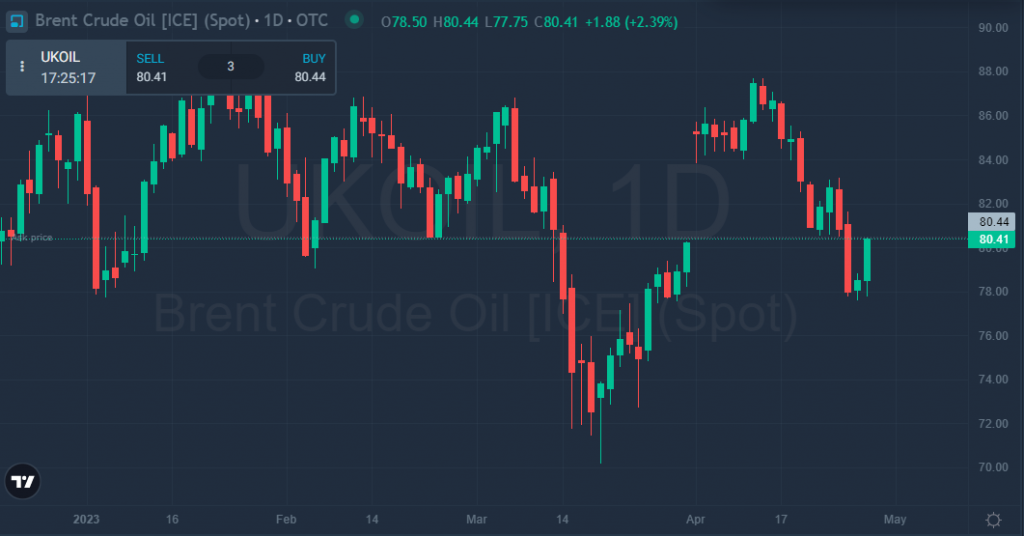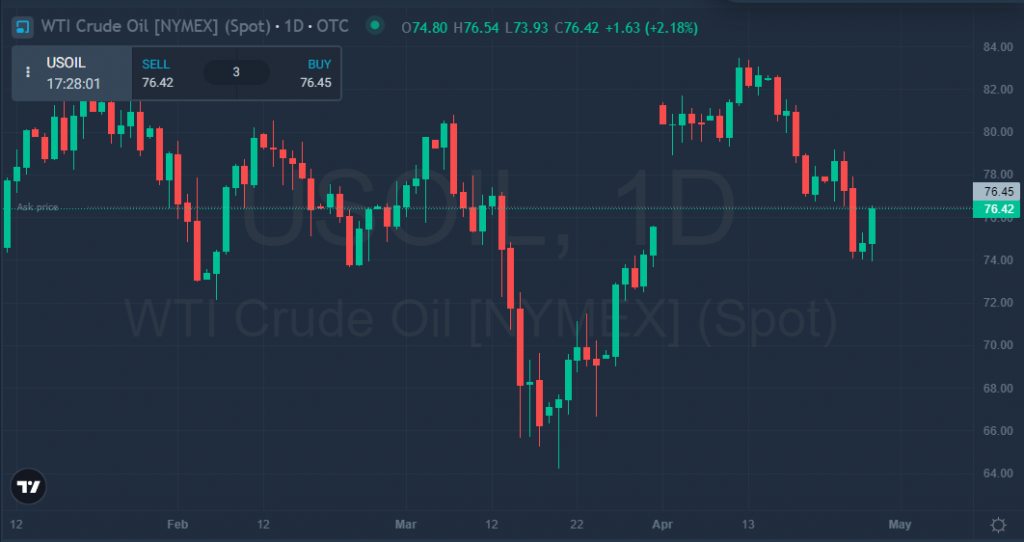Crude oil is one of the world’s most widely traded commodities. That said, oil is also a tricky commodity to trade, as you’re about to learn in a moment. In this article, we will review its key features. You will also find out the best places to trade it. Moreover, we will try to find out how to trade oil. Are you a seasoned trader or just getting started? These tips can help you confidently approach the oil market and increase your chances of success.
Table of contents:
1. Oil Market Basics—Understanding the Oil Market
In order to trade oil effectively, you need to have a solid understanding of the oil market. One part is understanding the supply and demand dynamics that influence oil prices. Additionally, it is important to be aware of the geopolitical factors and other market forces that can impact the market.
1.1. Oil Is Volatile
The oil market is known for its high levels of volatility. Prices often experience sudden and sharp movements in response to news and events. For example, in 2020, oil prices experienced a historic drop. This was due to the COVID-19 pandemic leading to a significant decrease in global demand for oil. This drop was followed by a sharp rebound in prices. Vaccine rollouts and economic stimulus measures led to a recovery in global demand.

1.2. Oil Is Global
The oil market is truly a global market, with oil produced and consumed in countries around the world. As such, events in one part of the world can have significant implications for oil prices and supply and demand dynamics in other parts of the world. For example, political instability in the Middle East can lead to disruptions in oil supply, which can drive up prices globally.
Read also: Top 4 Car Stocks to Trade in 2023
1.3. Oil Is sensitive to geopolitical risks
The oil market is highly sensitive to geopolitical risks, such as conflicts between oil-producing countries or changes in trade agreements. These events can significantly impact oil prices and supply and demand dynamics.
For example, tensions between the US and Iran in 2019 led to a spike in oil prices as investors anticipated potential disruptions in the global oil supply.
1.4. Oil Goes Through Cycles of Boom and Bust
The oil market is characterized by boom and bust cycles, with periods of high prices and strong demand followed by periods of low prices and oversupply. These cycles are often driven by global supply and demand changes and shifts in consumer behavior and government policies.
For example, the shale oil boom in the US in the early 2010s led to oversupply and low prices, while the OPEC production cut in 2016 helped stabilize prices and reduce oversupply.
1.5. Oil Has Diverse participants
The oil market is home to diverse participants, including producers, consumers, traders, and investors. This diversity of participants can create a complex and dynamic market environment with a wide range of opinions and interests at play.
Read also: How To Build a Stock Trading Strategy?
For example, oil producers may be motivated to maintain high prices, while oil consumers may seek to keep prices low. Traders and investors may take a range of positions in the market based on their outlook for oil prices and risk tolerance.
1.6. Oil May Face Difficulties Due To Sustainable Energy Source Development
The increasing adoption of sustainable energy and electric vehicles (EVs) is expected to reduce demand for oil-based products such as gasoline and diesel fuel, which could lead to a decline in crude oil prices.
The growth of the EV market is also expected to impact demand for oil-based electricity generation. Governments are implementing policies to encourage the adoption of sustainable energy and EVs, which is expected to further accelerate the transition away from oil-based products.
Overall, the impact of sustainable energy and EV markets on the crude oil market is complex and multifaceted.

Read also: How to Trade Economic Events. We’ll Let You Know When They Arrive
2. Crue Oil Supply and Demand Dynamics
Oil supply and demand are the two primary drivers of oil prices. On the supply side, oil prices are influenced by the production levels of oil-producing countries and the amount of oil available for purchase on the global market. Factors that can affect oil supply include geopolitical events, natural disasters, and technological advancements in oil extraction methods.
3. Geopolitical and Other Market Forces
On the demand side, oil prices are influenced by the level of global economic growth and changes in consumer behavior and government policies. For example, if global economic growth is strong, there is likely to be an increase in demand for oil as businesses and consumers require more energy. Government policies, such as fuel efficiency standards or taxes on oil consumption, can also affect oil demand.
The balance between oil supply and demand is constantly shifting, which can cause oil prices to fluctuate. If oil supply exceeds demand, there is likely to be downward pressure on oil prices, while a shortage of supply relative to demand can drive prices upward. Understanding the supply and demand dynamics of the oil market is very important. It would help you to predict future price movements and make informed trading decisions.

4. Brent or WTI Crude Oil?
Brent crude oil and West Texas Intermediate (WTI) crude oil are two of the world’s most commonly traded types of crude oil. Here is a comparison of the two types of oil, along with some historical examples:
- Production and geography: Brent crude oil is produced in the North Sea region of Europe, while WTI crude oil is produced in the United States, primarily in Texas. Historically, Brent crude oil has been more widely traded globally. WTI crude oil has been primarily traded within the United States.
- Quality: Brent crude oil is typically considered to be of higher quality than WTI crude oil, as it has a lower sulfur content and is easier to refine into gasoline and diesel fuel. However, the quality of crude oil can vary widely, depending on the source and production method.
- Price: Historically, Brent crude oil has typically traded at a premium to WTI crude oil due in part to the higher demand for Brent crude oil globally. However, there have been periods when WTI crude oil has traded at a premium to Brent crude oil. It was in 2011-2014, when booming US shale production led to a glut of WTI crude oil in the domestic market. As a result, prices dropped.
- Trading volumes: Brent crude oil is typically traded on London’s Intercontinental Exchange (ICE). Investors can trade WTI crude oil primarily on the New York Mercantile Exchange (NYMEX) in New York.
Brent and WTI crude oil share many similarities. They also have unique characteristics. They are both influenced by different market factors. Understanding the similarities and differences between the two types of crude oil. Especially for investors and traders looking to trade oil futures or oil-related equities. You can trade both Brent and WTI crude oil stocks anonymously using the SimpleFX trading app.
Read also: How to Trade Stocks with Little Money Using SimpleFX

